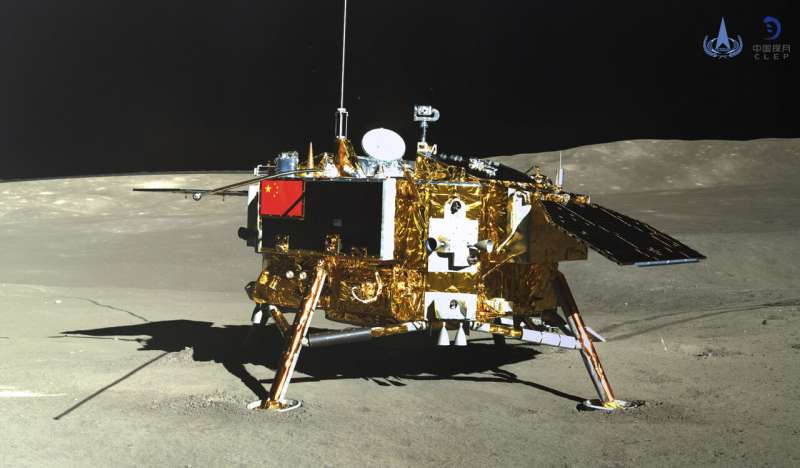
Copernical Team
SpaceX completes bicoastal launches, adding to Starlink's megaconstellation
 SpaceX launched another group of 23 satellites from Kennedy Space Center on Thursday night via a Falcon 9 rocket, adding to the Starlink megacluster of Internet satellites now in low-Earth orbit.
The launches have become nearly routine as have the return of reusable fuel cell booster rocket to a drone awaiting below.
Thursday night, the booster, guided by short rocket bursts, returne
SpaceX launched another group of 23 satellites from Kennedy Space Center on Thursday night via a Falcon 9 rocket, adding to the Starlink megacluster of Internet satellites now in low-Earth orbit.
The launches have become nearly routine as have the return of reusable fuel cell booster rocket to a drone awaiting below.
Thursday night, the booster, guided by short rocket bursts, returne China launches first probe to collect samples from far side of Moon
 China launched a probe on Friday to collect samples from the far side of the Moon, a world first as Beijing pushes ahead with an ambitious programme that aims to send a crewed lunar mission by 2030.
A rocket carrying the Chang'e-6 lunar probe blasted off from the Wenchang Space Launch Centre in southern China's Hainan province just before 5:30 pm (0930 GMT), AFP journalists near the site s
China launched a probe on Friday to collect samples from the far side of the Moon, a world first as Beijing pushes ahead with an ambitious programme that aims to send a crewed lunar mission by 2030.
A rocket carrying the Chang'e-6 lunar probe blasted off from the Wenchang Space Launch Centre in southern China's Hainan province just before 5:30 pm (0930 GMT), AFP journalists near the site s Ariane 6 launches: Exolaunch’s EXOpod Nova

Europe’s newest rocket soon launches, taking with it many space missions each with a unique objective, destination and team at home, cheering them on. Whether launching new satellites to look back and study Earth, peer out to deep space or test important new technologies in orbit, Ariane 6’s first flight will showcase the versatility and flexibility of this impressive, heavy-lift launcher. Read on for all about EXOpod Nova, then see who else is flying first.
Seven ways ESA has cut its environmental footprint

ESA is committed to almost halve its greenhouse gas emissions linked to energy consumption by 2025 compared to 2019 levels. But how can ESA keep accelerating the use of space for the sustainable development of society while reducing its emissions?
Earth from Space: Namibian landforms
 Image:
This image may resemble the surface of Mars, but it was actually captured by the Copernicus Sentinel-2 mission, revealing the stunning terrain of northwest Namibia.
Image:
This image may resemble the surface of Mars, but it was actually captured by the Copernicus Sentinel-2 mission, revealing the stunning terrain of northwest Namibia. Week in images: 29 April - 03 May 2024

Week in images: 29 April - 03 May 2024
Discover our week through the lens
China is sending a probe to get samples from the less-explored far side of the moon

UTA scientists explore quantum aspects of gravity using neutrinos
 Einstein's theory of general relativity describes gravity as a result of space and time curving. This theory accounts for the Earth's gravity, which anchors us and causes objects to fall.
In contrast, high-energy physics investigates subatomic particles that follow the principles of quantum mechanics, notable for their random fluctuations and the inherent uncertainty in particle positions
Einstein's theory of general relativity describes gravity as a result of space and time curving. This theory accounts for the Earth's gravity, which anchors us and causes objects to fall.
In contrast, high-energy physics investigates subatomic particles that follow the principles of quantum mechanics, notable for their random fluctuations and the inherent uncertainty in particle positions Microsoft announces $2.2 bn AI, cloud investment in Malaysia
 Microsoft pledged a $2.2 billion investment in artificial intelligence and cloud computing in Malaysia on Thursday to help develop the country's AI infrastructure.
The tech giant's chief executive Satya Nadella is on a three-nation tour of Southeast Asia - Indonesia, Thailand and Malaysia - to announce a range of investments in data centres, AI and cloud services.
"Today, Microsoft ann
Microsoft pledged a $2.2 billion investment in artificial intelligence and cloud computing in Malaysia on Thursday to help develop the country's AI infrastructure.
The tech giant's chief executive Satya Nadella is on a three-nation tour of Southeast Asia - Indonesia, Thailand and Malaysia - to announce a range of investments in data centres, AI and cloud services.
"Today, Microsoft ann X-ray satellite XMM-newton sees 'space clover' in a new light
 Astronomers have discovered enormous circular radio features of unknown origin around some galaxies. Now, new observations of one dubbed the Cloverleaf suggest it was created by clashing groups of galaxies.
Studying these structures, collectively called ORCs (odd radio circles), in a different kind of light offered scientists a chance to probe everything from supersonic shock waves to blac
Astronomers have discovered enormous circular radio features of unknown origin around some galaxies. Now, new observations of one dubbed the Cloverleaf suggest it was created by clashing groups of galaxies.
Studying these structures, collectively called ORCs (odd radio circles), in a different kind of light offered scientists a chance to probe everything from supersonic shock waves to blac 
